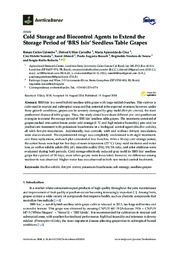Cold Storage and Biocontrol Agents to Extend the Storage Period of ?BRS Isis? Seedless Table Grapes.
Cold Storage and Biocontrol Agents to Extend the Storage Period of ?BRS Isis? Seedless Table Grapes.
Autoria: COLOMBO, R. C.; CARVALHO, D. U.; CRUZ, M. A. da; SUMIDA, C. H.; AHMED, S.; BASSOLI, P. A.; SOUZA, R. T. de; ROBERTO, S. R.
Resumo: "BRS Isis" is a novel hybrid seedless table grape with large reddish bunches. This cultivar is cultivated in tropical and subtropical areas and has potential to be exported overseas; however, under these growth conditions, grapes can be severely damaged by gray mold (Botrytis cinerea), the main postharvest disease of table grapes. Thus, this study aimed to evaluate different pre- and postharvest strategies to extend the storage period of ?BRS Isis? seedless table grapes. The treatments consisted of grapes packed into carton boxes under cold storage (1 ◦C and high relative humidity), pre- and/or postharvest treatment with potassium bicarbonate or a biological control agent (Bacillus subtilis), all with Botrytis inoculation. Additionally, two controls, with and without Botrytis inoculation, were also evaluated. The experimental design was completely randomized with eight treatments and three replications, and each plot consisted of four bunches. After a 50-day cold storage period, the carton boxes were kept for five days at room temperature (22 ◦C). Gray mold incidence and water loss, as well as soluble solids (SS), pH, titratable acidity (TA), SS/TA ratio, and color attributes were evaluated during both periods. Cold storage effectively reduced gray mold in "BRS Isis" seedless grape for a period of 50 days, even when grapes were inoculated; however, no difference among treatments was observed. Higher water loss was observed in both non-treated control treatments. Keywords: Bacillus subtilis; Botrytis cinerea; potassium bicarbonate; salt strategy; seedless grapes
Ano de publicação: 2018
Tipo de publicação: Artigo de periódico
Unidade: Embrapa Uva e Vinho
Palavras-chave: Bacillus subtilis, Botrytis Cinerea, Potassium bicarbonate, Salt strategy, Seedless grapes
Observações
1 - Por padrão são exibidas publicações dos últimos 20 anos. Para encontrar publicações mais antigas, configure o filtro ano de publicação, colocando o ano a partir do qual você deseja encontrar publicações. O filtro está na coluna da esquerda na busca acima.
2 - Para ler algumas publicações da Embrapa (apenas as que estão em formato ePub), é necessário ter, no celular ou computador, um desses softwares gratuitos. Sistemas Android: Google Play Livros; IOS: iBooks; Windows e Linux: software Calibre.
Acesse outras publicações
Acesse a Base de Dados da Pesquisa Agropecuária (BDPA) para consultar o acervo completo das bibliotecas da Embrapa.

